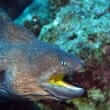Background
- Ciguatera fish poisoning (or ciguatera) is caused by eating fish that contain toxins produced by the marine dinoflagellate microalga Gambierdiscus toxicus.
- Ciguatera causes gastrointestinal, neurological, and cardiovascular symptoms. Signs and symptoms vary widely, but ciguatera usually presents as gastrointestinal symptoms, such as nausea, vomiting, diarrhea, and abdominal pain, accompanied by neurologic complaints, shortly after the ingestion of fish containing the toxins. Symptoms of ciguatera poisoning may persist for months or years.
- Epidemics are most common along tropical and subtropical coasts and usually involve the ingestion of large carnivorous fish. Ciguatera toxins account for over half of fish-related poisonings in the United States. The toxins are odorless and tasteless. Fish known to have carried ciguatera toxins include barracuda, black grouper, blackfin snapper, cubera snapper, dog snapper, greater amberjack, hogfish, horse-eye jack, king mackerel, and yellowfin grouper.
- Estimates place the annual number of ciguatera cases at 20,000 worldwide.
References
- Arcila-Herrera H, Castello-Navarrete A, Mendoza-Ayora J, et al. [Ten cases of Ciguatera fish poisoning in Yucatan]. Rev Invest Clin 1998;50(2):149-152. View Abstract
- Asaeda G. The transport of ciguatoxin: a case report. J Emerg Med 2001;20(3):263-265. View Abstract
- Barton ED, Tanner P, Turchen SG, et al. Ciguatera fish poisoning. A southern California epidemic. West J Med 1995;163(1):31-35. View Abstract
- Calvert GM, Hryhorczuk DO, Leikin JB. Treatment of ciguatera fish poisoning with amitriptyline and nifedipine. J Toxicol Clin Toxicol 1987;25(5):423-428. View Abstract
- Dalzell P. Ciguatera fish poisoning and fisheries development in the South Pacific Region. Bull Soc Pathol Exot 1992;85(5 Pt 2):435-444. View Abstract
- DeFusco DJ, O'Dowd P, Hokama Y, et al. Coma due to ciguatera poisoning in Rhode Island. Am J Med 1993;95(2):240-243. View Abstract
- de Haro L, Pommier P, Valli M. Emergence of imported ciguatera in Europe: report of 18 cases at the Poison Control Centre of Marseille. J Toxicol Clin Toxicol 2003;41(7):927-930. View Abstract
- Hashmi MA, Sorokin JJ, Levine SM. Ciguatera fish poisoning. N J Med 1989;86(6):469-471. View Abstract
- Heir GM. Ciguatera neurotoxin poisoning mimicking burning mouth syndrome. Quintessence Int 2005;36(7-8):547-550. View Abstract
- Lewis RJ. Socioeconomic impacts and management ciguatera in the Pacific. Bull Soc Pathol Exot 1992;85(5 Pt 2):427-434. View Abstract
- Lipp EK, Rose JB. The role of seafood in foodborne diseases in the United States of America. Rev Sci Tech 1997;16(2):620-640. View Abstract
- Lueger A, Scherr D, Lang B, et al. [Marine toxins]. Wien Med Wochenschr 1999;151(5-6):122-125. View Abstract
- Park DL. Evolution of methods for assessing ciguatera toxins in fish. Rev Environ Contam Toxicol 1994;136:1-20. View Abstract
- Ting JY, Brown AF. Ciguatera poisoning: a global issue with common management problems. Eur J Emerg Med 2001;8(4):295-300. View Abstract
- Zlotnick BA, Hintz S, Park DL, et al. Ciguatera poisoning after ingestion of imported jellyfish: diagnostic application of serum immunoassay. Wilderness Environ Med 1995;6(3):288-294. View Abstract







